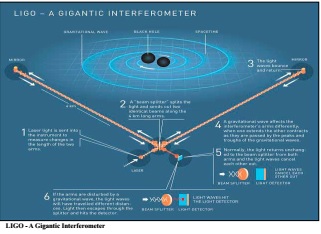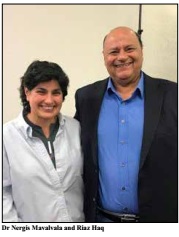Pakistani-American Astrophysicist Dr Nergis Mavalvala in Silicon Valley
By Riaz Haq

Pakistani-American astrophysicist Dr Nergis Mavalvala, MIT professor and member of Nobel Prize winner LIGO team, visited Pakistani-American Community Center (PACC) in Silicon Valley on February 24, 2018. She was invited by PACC founder Mr Mohammad Asghar Aboobaker to talk about her inspirational work and meet with the community members, particularly Pakistani-American youngsters in the Valley.

Who is Nergis?
Nergis was born in Lahore and raised in Karachi before coming to the United States in 1986. She completed her PhD in Physics from the Massachusetts Institute of Technology (MIT) in 1997. She did her doctoral work under Dr Rainer Weiss that included developing a prototype laser interferometer for detecting gravitational waves. Currently, she is Curtis and Kathleen Marble Professor of Astrophysics at the Massachusetts Institute of Technology (MIT), where she is also the Associate Head of the Department of Physics.
Gravitational Waves
In her brief presentation attended by over 100 people including boys and girls, Nergis explained Albert Einstein's gravitational wave theory and described her work in confirming the theory by detecting gravitational waves in Laser Interferometer Gravitational-Wave Observatory (LIGO) project.

Gravitational waves are the disturbances in the fabric ("curvature") of space-time generated by accelerated stars and propagate as waves outward from their source at the speed of light. She compared the gravitational waves with the curvature and the ripples produced in a trampoline when a heavy ball is placed in the middle and bounced on it.
All Stars Die
Nergis explained that allstars, like the sun in our solar system, are born, grow and eventually die. Our sun too will die but she assured her audience that it won't happen for over a billion years. She described black holes as big stars whose light cannot escape due to their massive gravity. Huge amounts of energy are released when these massive stars collide with each other and new ones are born.
Neutron stars are created when giant stars die in supernovas and their cores collapse, with the protons and electrons essentially melting into each other to form neutrons. Given the extremely small waves of about 1,000 times smaller than a proton, the equipment required for detecting them must be extremely sensitive to tiny disturbances. LIGO equipment uses giant shock absorbers to eliminate extraneous perturbations that can alter the result.
Detected gravitational waves help scientists understand how large and how far away the colliding stars are, and allow them to recreate the moments before they collided. After such collisions, the measurements of optical light and electromagnetic waves fill in the blanks that gravitational waves can’t answer.
Origins of Gold
In answer to my question about the events detected by the LIGO team, Nergis said the gravitational waves generated by these neutron star collisions occurred over a billion years ago at a distance of a billion light years. From optical light and electromagnetic measurements after these collisions, scientists were able to conclude that the resulting explosion from a neutron star merger produces heavy elements like gold, platinum, and uranium. These collisions occurred well after the Big Bang that is believed to have happened about 13.7 billion years ago. Detecting events that occurred closer to the Big Bang would take much more sensitive equipment than currently available to the LIGO team.
Mavalvala and her team members of the Laser Interferometer Gravitational-Wave Observatory (LIGO) project have opened new vistas in human pursuit to solve the mysteries of our universe. The collision of stars they have detected occurred over a billion years ago. With their new equipment they hope to go back further closer to the Big Bang to learn more about the creation of our universe.
-----------------------------------------------------------------------------

